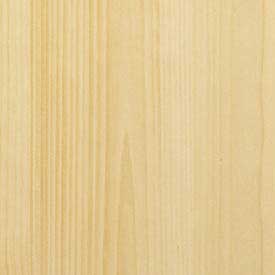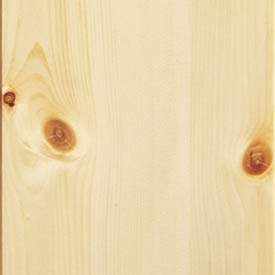Pine
General Info and Benefits
Pine – of the family Pinaceae
General Description
• The sapwood is a yellowish white. The heartwood is a reddish brown, orange, or yellow.
• The sapwood is usually wide in second growth stands. Heartwood begins to form when the tree is about 20 years old.
• In old, slow-growth trees, sapwood may be only 1 to 2 inches in width.
• The heartwood is rated as moderate to low in resistance to decay. The sapwood is more easily impregnated with preservatives.
• Pines are susceptible to fungus discoloration called Blue Stain.
Physical Properties
• Janka Rating System = 690 (higher Janka rating = harder wood)
Where It Grows
• Throughout the U.S. and Canada in different species
Relative Abundance
• Its many species are found throughout the U.S. and Canada in large swaths. Thus it is considered a renewable, sustainable material.
• Readily available as construction material, plywood and particle board as well as veneers.
Did You Know?
• The resin of some species is an important source of turpentine
• At least 28 species readily available within the U.S.
• Pine nuts are the seeds of certain pine species
General Description
• The sapwood is a yellowish white. The heartwood is a reddish brown, orange, or yellow.
• The sapwood is usually wide in second growth stands. Heartwood begins to form when the tree is about 20 years old.
• In old, slow-growth trees, sapwood may be only 1 to 2 inches in width.
• The heartwood is rated as moderate to low in resistance to decay. The sapwood is more easily impregnated with preservatives.
• Pines are susceptible to fungus discoloration called Blue Stain.
Physical Properties
• Janka Rating System = 690 (higher Janka rating = harder wood)
Where It Grows
• Throughout the U.S. and Canada in different species
Relative Abundance
• Its many species are found throughout the U.S. and Canada in large swaths. Thus it is considered a renewable, sustainable material.
• Readily available as construction material, plywood and particle board as well as veneers.
Did You Know?
• The resin of some species is an important source of turpentine
• At least 28 species readily available within the U.S.
• Pine nuts are the seeds of certain pine species
-
 Pine ClearClear Pine ranges from white sapwood and pale-brown to reddish-brown heartwood. This material has a reduced allowance for characteristics like small closed knots, pin knots and color variation.
Pine ClearClear Pine ranges from white sapwood and pale-brown to reddish-brown heartwood. This material has a reduced allowance for characteristics like small closed knots, pin knots and color variation. -
 Pine KnottyKnotty Pine has medium-coarse texture and even grain and has an allowance for larger-size, closed knots, knots containing star cracks, color variation, pitch pockets and pin knots.
Pine KnottyKnotty Pine has medium-coarse texture and even grain and has an allowance for larger-size, closed knots, knots containing star cracks, color variation, pitch pockets and pin knots.